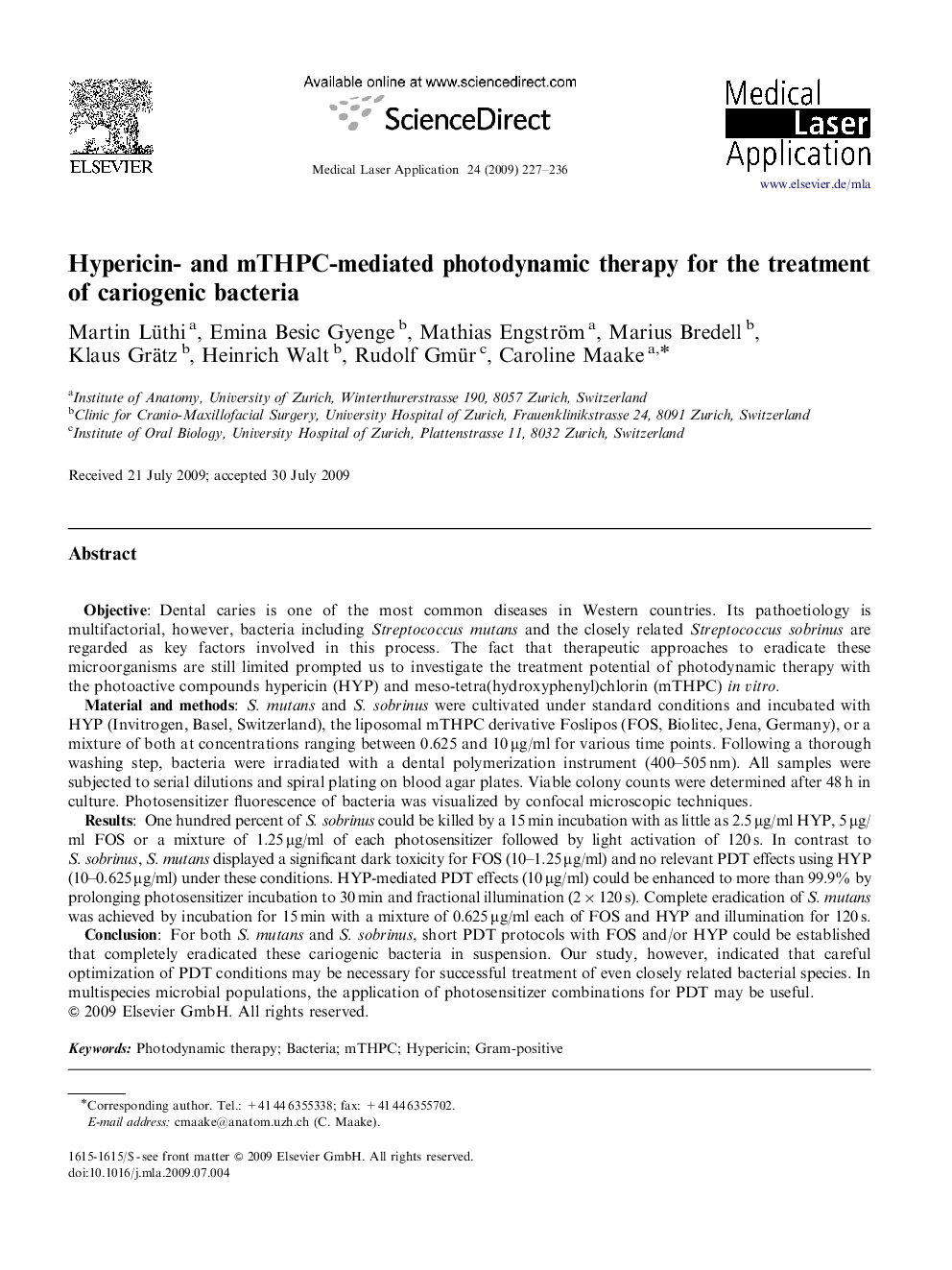| کد مقاله | کد نشریه | سال انتشار | مقاله انگلیسی | نسخه تمام متن |
|---|---|---|---|---|
| 2068198 | 1544392 | 2009 | 10 صفحه PDF | دانلود رایگان |

ObjectiveDental caries is one of the most common diseases in Western countries. Its pathoetiology is multifactorial, however, bacteria including Streptococcus mutans and the closely related Streptococcus sobrinus are regarded as key factors involved in this process. The fact that therapeutic approaches to eradicate these microorganisms are still limited prompted us to investigate the treatment potential of photodynamic therapy with the photoactive compounds hypericin (HYP) and meso-tetra(hydroxyphenyl)chlorin (mTHPC) in vitro.Material and methodsS. mutans and S. sobrinus were cultivated under standard conditions and incubated with HYP (Invitrogen, Basel, Switzerland), the liposomal mTHPC derivative Foslipos (FOS, Biolitec, Jena, Germany), or a mixture of both at concentrations ranging between 0.625 and 10 μg/ml for various time points. Following a thorough washing step, bacteria were irradiated with a dental polymerization instrument (400–505 nm). All samples were subjected to serial dilutions and spiral plating on blood agar plates. Viable colony counts were determined after 48 h in culture. Photosensitizer fluorescence of bacteria was visualized by confocal microscopic techniques.ResultsOne hundred percent of S. sobrinus could be killed by a 15 min incubation with as little as 2.5 μg/ml HYP, 5 μg/ml FOS or a mixture of 1.25 μg/ml of each photosensitizer followed by light activation of 120 s. In contrast to S. sobrinus, S. mutans displayed a significant dark toxicity for FOS (10–1.25 μg/ml) and no relevant PDT effects using HYP (10–0.625 μg/ml) under these conditions. HYP-mediated PDT effects (10 μg/ml) could be enhanced to more than 99.9% by prolonging photosensitizer incubation to 30 min and fractional illumination (2×120 s). Complete eradication of S. mutans was achieved by incubation for 15 min with a mixture of 0.625 μg/ml each of FOS and HYP and illumination for 120 s.ConclusionFor both S. mutans and S. sobrinus, short PDT protocols with FOS and/or HYP could be established that completely eradicated these cariogenic bacteria in suspension. Our study, however, indicated that careful optimization of PDT conditions may be necessary for successful treatment of even closely related bacterial species. In multispecies microbial populations, the application of photosensitizer combinations for PDT may be useful.
ZusammenfassungZielsetzungKaries gehürt zu den häufigsten Erkrankungen in den westlichen Ländern. Wenngleich vermutlich multiple Faktoren eine ursächliche Rolle spielen, so wird doch den verwandten Bakterien Streptococcus mutans und Streptococcus sobrinus eine Schlüsselrolle für die Pathoätiologie von Karies zugesprochen. Da geeignete antibakterielle Behandlungsmüglichkeiten zur Zeit fehlen, haben wir in der vorliegenden Arbeit das Potential einer photodynamischen Therapie (PDT) mit den photoaktiven Substanzen Hypericin (HYP) und meso-Tetra(hydroxyphenyl)chlorin (mTHPC) in vitro untersucht.Material und MethodenS. mutans und S. sobrinus wurden routinemässig kultiviert und mit HYP (Invitrogen, Basel, Schweiz), dem liposomalen mTHPC-Derivativ Foslipos (FOS, Biolitec, Jena, Deutschland) oder einer Mischung aus beiden mit Konzentrationen von 0.625–10 μg/ml unterschiedlich lang inkubiert. Nach sorgfältigen Wasch-Schritten wurden die Bakterien mit einer zahnärztlichen Polymerisationslampe bei 400–505 nm bestrahlt. Die Proben wurden dann seriell verdünnt und auf Blut-Agar-Platten ausspiralisiert. Überlebende Kolonien wurden nach 48 h ausgezählt. Ausserdem wurde die Fluoreszenz der Photosensibilisatoren an den Bakterien mit einem Konfokalmikroskop untersucht.ErgebnisseS. sobrinus konnte zu 100% abgetütet werden durch eine 15-minütige Inkubation mit 2,5 μg/ml HYP, 5 μg/ml FOS oder einer Mischung von 1.25 μg/ml beider Photosensibilisatoren und anschlieβender Lichtaktivierung für 120 s. Im Gegensatz zu S. sobrinus zeigte S. mutans unter diesen Bedingungen eine signifikante Dunkeltoxizität für FOS (10–1.25 μg/ml) und keine relevanten PDT-Effekte für HYP (10–0.625 μg/ml). HYP-bedingte PDT-Effekte (10 μg/ml) konnten aber durch Verlängerung der Inkubationszeit auf 30 min und eine fraktionierte Bestrahlung (2×120 s) auf mehr als 99.9% erhüht werden. Eine vollständige Eliminierung von S. mutans konnte durch eine 15-minütige Behandlung mit einer Mischung von je 0.625 μg/ml FOS und HYP und einer Belichtung von 120 s erzielt werden.SchlussfolgerungenSowohl für S. mutans wie auch für S. sobrinus konnten kurze PDT-Protokolle mit FOS und/oder HYP entwickelt werden, welche zur vollständigen Abtütung dieser beiden kariogenen Keime in Suspension führten. Unsere Studie zeigte aber auch, dass die Behandlung verwandter Keime eine sorgfältige Optimierung der PDT-Bedingungen notwendig machen kann. Die Verwendung von Photosensibilisator-Kombinationen künnte für die Therapie von mikrobiellen Multispezies-Populationen hilfreich sein.
Journal: Medical Laser Application - Volume 24, Issue 4, 5 December 2009, Pages 227–236